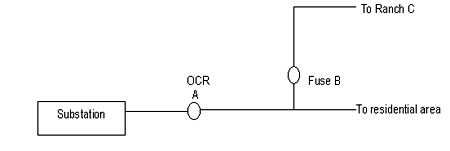Have you ever noticed your lights blink during a thunderstorm? How about coming home from work, or worse waking up in the morning to find your electronic clocks blinking? The powerline that serves your home probably experienced a blink or brief power interruption. There are basically two reasons why these blinks occur. A blink can occur because of a fault (short circuit) on the powerline, or the operation of a protective device working in reaction to a fault.
A temporary fault on a powerline will result in a quick blink and can be caused in a number of ways, including: wires slapping together during a storm, a bull rubbing on a guy wire, a tree branch hitting a powerline, a bird or animal touching an energized part and grounded part at the same time, lightning, or other similar events.
If the damage to a powerline is severe enough, a fault can allow a large amount of electric current to flow through the lines. High Plains Power has installed protective devices on our powerlines, called OCR's (oil circuit reclosers, sometimes called breakers) and fused cutouts (fuses) that detect these fault currents. When the fault current exceeds a certain limit, the fuse in a fused cutout will blow and disconnect a section of line. An OCR reacts to a fault by beginning a series of internal switching operations. It opens and closes a switch, as many as three times, testing to see if the fault has cleared itself. On the fourth operation, if the fault is still there, the OCR will remain open and disconnect the line segment. In either case, a line crew will have to repair the damaged powerline and then refuse the cutout or close the OCR to restore electric service.
High Plains Power improves service reliability by coordinating the operation of OCR's and fuses on a powerline circuit. This coordination limits the number of customers that may be affected by a fault on a segment of line. This sectionalizing plan works as follows:

A storm passes through and a tree branch falls on the line between Fuse B and Ranch C. The tree branch creates a fault that causes Fuse B to blow. There is now an outage at Ranch C and a crew will have to repair the damage caused by the tree branch and then refuse the cutout at B to restore service to Ranch C. However, if your home is in the residential area past OCR-A and the tap to Ranch C, you still may experience a blink in your lights. This blink is intentional and is caused by an operation of the OCR. This operation is designed to allow time for the fuse to blow and separate the damaged powerline from the source. If after a few blinks (four or less) the lights in the residential area return to normal, the sectionalizing plan has worked. The problem line has been isolated from the rest of the circuit and limited the number of customers without power.
Your call to report an outage is very important because it helps our crews to locate the problem and make necessary repairs. Any additional information you may have is also very important. Some of the situations that you need to report to help our line crews locate the problem are listed below:
- Any power line that looks abnormal or is lying on the ground. Please keep everyone away from a downed powerline and call High Plains immediately.
- If you hear a loud boom or see a bright flash just prior to the lights going out, the location of that flash or noise is helpful to our linemen.
- Tell us if your lights are out but you can see that your neighbors have lights.
- When powerlines travel through trees and the trees become damp due to snow or rain, the powerline coming in contact with the tree can cause the lights to blink. If you observe this situation, please notify the office so that properly trained crews can be dispatched to trim the trees and correct the problem.
Your help in providing information is very important and reduces the time necessary to restore power. Please call us at 1-800-445-0613 to report an outage or dangerous situation.
